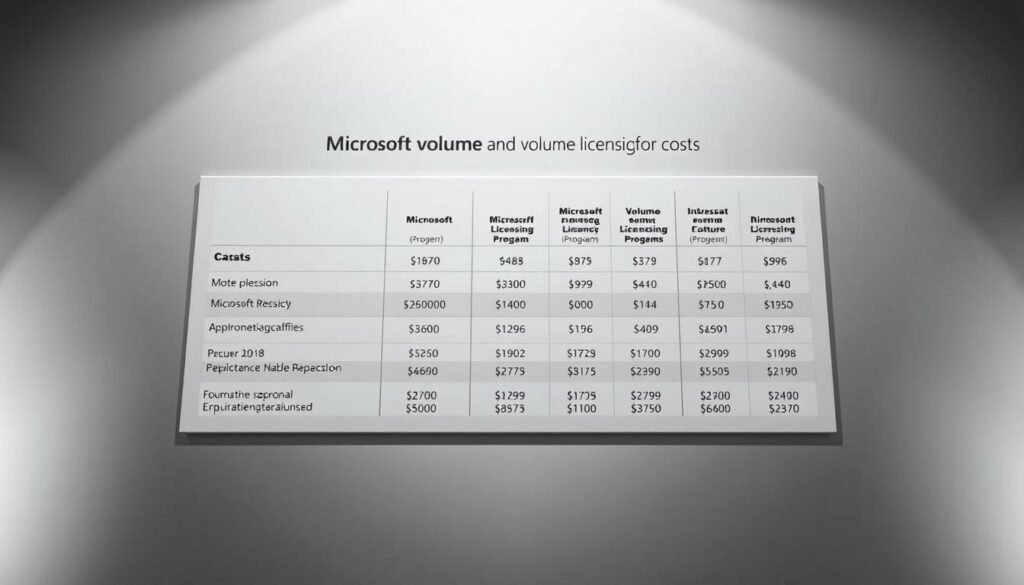Microsoft has a flexible licensing program for different organizations. Microsoft Volume Licensing helps government, educational, and nonprofit groups. It lets them use a variety of Microsoft products and services.
These groups get special prices and terms. This makes it simpler for them to use Microsoft solutions. If you’re in government, education, or a nonprofit, Microsoft’s licensing programs can help you reach your goals.
Key Takeaways
- Microsoft Volume Licensing offers flexible options for various organizations.
- Government, educational, and nonprofit entities can benefit from special pricing and terms.
- Tailored licensing programs are available to meet the unique needs of different organizations.
- Microsoft Volume Licensing provides access to a wide range of Microsoft products and services.
- Eligible organizations can adopt Microsoft solutions with ease.
What is Microsoft Volume Licensing?
For businesses, Microsoft Volume Licensing is a great way to manage software licenses. It makes handling many licenses easy. This is perfect for companies of all sizes.
Overview of Volume Licensing Models
Microsoft Volume Licensing has different models for various needs. You can choose from the Open License Program, Select Plus Licensing, and Enterprise Agreements. Each model offers flexibility and saves money, fitting your business needs.
The Open License Program is best for small to medium-sized businesses. Select Plus Licensing and Enterprise Agreements are for bigger companies with more complex needs.
Benefits of Volume Licensing
Microsoft Volume Licensing makes managing licenses easy and saves money. It combines licenses into one deal. This cuts down on paperwork and lowers costs.
It also gives access to software updates and upgrades. This keeps your business running smoothly and competitive.
Types of Microsoft Volume Licensing Programs
Organizations have many Microsoft volume licensing programs to choose from. Each is made for different business needs. This way, businesses can find a program that fits their size, structure, and budget.
Open License Program
The Open License Program is for small to medium-sized businesses. It makes buying Microsoft product licenses easy. It’s perfect for businesses that need a certain number of licenses quickly.
Key benefits of the Open License Program include:
- Simplified license acquisition process
- Flexibility in purchasing licenses as needed
- No requirement for a long-term commitment
Select Plus Licensing
Select Plus Licensing is for bigger organizations with complex needs. It offers a lot of flexibility and customization. This lets organizations tailor their licensing to fit their exact needs.
Advantages of Select Plus Licensing include:
- Customizable licensing agreements
- Ability to manage licenses across multiple locations
- Access to various Microsoft products and services
Enterprise Agreements
Enterprise Agreements are for large organizations with big licensing needs. This program offers a full solution for Microsoft products and services.
Key features of Enterprise Agreements include:
- Comprehensive licensing coverage for Microsoft products
- Simplified license management across the organization
- Options for adding or removing licenses as needed
Understanding the different Microsoft volume licensing programs helps organizations make better choices. They can pick the program that matches their business goals.
How to Choose the Right Volume Licensing Program
Microsoft offers many Volume Licensing programs. To pick the right one, you need to know what your company needs. This means looking at your current and future needs to find a program that fits your goals.
Assessing Your Organization’s Needs
First, figure out what your company really needs. Think about how many users you have, the Microsoft products you use, and your budget. Knowing your company’s size and scope is key to finding the best licensing program.
For example, a small to medium-sized business (SME) might need a different solution than a big company. SMEs might prefer programs that are flexible and can grow with them. On the other hand, big companies might need programs that handle complex agreements and lots of users.
“The key to successful licensing is understanding your organization’s needs and choosing a program that aligns with those needs.”
Comparing Features and Pricing
After figuring out what you need, compare the features and prices of different programs. Look at the cost of licenses, how flexible the program is, and the support Microsoft offers.
| Licensing Program | Features | Pricing |
|---|---|---|
| Open License Program | Flexible, scalable, suitable for SMEs | Competitive pricing for small to medium-sized orders |
| Enterprise Agreement | Comprehensive, includes Software Assurance, suitable for large organizations | Discounted pricing for large orders, commitment required |
When looking at features and prices, think about the total cost and the benefits. Volume licensing costs can be high, so it’s important to understand the pricing and how it fits your budget.

By carefully looking at your needs and comparing different programs, you can make a smart choice. This choice should meet your business needs and budget.
Benefits of Microsoft Volume Licensing
Microsoft Volume Licensing offers many advantages. It helps organizations save money and get flexible solutions. This model meets the needs of different organizations, helping them get the most from Microsoft.
Cost-Effective Solutions
One big plus of Microsoft Volume Licensing is saving money. Buying in bulk, organizations can cut their software costs. This is great for big companies with lots of employees.
Microsoft Software Assurance adds even more value. It gives access to new software, support, and training. This keeps organizations current with the latest tech.
Access to Updates and Upgrades
Microsoft Volume Licensing also means getting updates and upgrades with Software Assurance. This makes it easy for companies to move to new Microsoft products. They get the latest features and security fixes.
With the latest software, companies can work better and faster. The support and training from Software Assurance also help use Microsoft products to their fullest.
In summary, Microsoft Volume Licensing offers great savings and access to updates. It’s a smart choice for companies looking to make the most of their Microsoft investments.
Licensing for Different Business Sizes
Microsoft offers a variety of licensing options for businesses of all sizes. Whether you’re a small startup or a big company, Microsoft has something for you. Their Volume Licensing is designed to fit your needs.
It’s important to know what your business needs before choosing a licensing program. Microsoft has options for small and medium-sized businesses (SMEs) and large corporations. Each has its own set of needs and challenges.
Small and Medium-Sized Enterprises (SMEs)
For SMEs, Microsoft has the Open License Program. It’s perfect for businesses with a few users. This program is easy to use and flexible.
SMEs can benefit in many ways:
- It’s easy to understand and manage
- No long-term commitment is needed
- You can buy more licenses as your business grows
Large Corporations
Large corporations need more complex solutions. Microsoft’s Enterprise Agreement is for businesses with 500 or more users/devices. It includes software assurance, giving access to the latest products and support.
Large corporations get these benefits:
- It simplifies license management
- There are cost savings through volume discounts
- Access to the latest Microsoft technologies and support
To show the differences, here’s a table comparing SMEs and large corporations:
| Features | Open License Program (SMEs) | Enterprise Agreement (Large Corporations) |
|---|---|---|
| Minimum License Requirement | 5 licenses | 500 licenses/users |
| Contract Duration | 2 years (with option to renew) | 3 years |
| Software Assurance | Optional | Included |
| Cost | Based on the number of licenses purchased | Discounted rates for large volumes |
In conclusion, Microsoft Volume Licensing offers flexible solutions for all business sizes. By understanding your business needs, you can pick the best licensing program. Whether you’re an SME or a large corporation, Microsoft has you covered.
Microsoft Volume Licensing and Compliance
Keeping up with Microsoft Volume Licensing rules is key for companies to avoid big problems. It’s not just about following the rules; it’s about making the most of your software.
Importance of Software Compliance
Staying compliant with Microsoft rules is essential. It means you’re using their products the right way. If you don’t, you could face big fines and harm your reputation.
Here’s why software compliance is so important:
- It helps you avoid legal and financial troubles
- It keeps your software up-to-date with the latest security
- It helps you use your software better and save resources
Best Practices for Maintaining Compliance
To stay compliant with Microsoft Volume Licensing, follow these steps:
Always check and update your licensing agreements to match your current needs.
Start a strong software asset management (SAM) program to keep track of all Microsoft software in your company.

By sticking to these tips and keeping up with Microsoft’s rules, you can stay compliant. This way, you get the most out of your Microsoft Volume Licensing deals.
Understanding Licensing Terms and Conditions
It’s key for companies to get the terms of Microsoft Volume Licensing right. This ensures they follow the rules and get the most from their software. Knowing these details helps businesses deal with licensing agreements and make smart choices about their software.
Licensing Agreements Explained
A Volume License Agreement is a deal between Microsoft and a company. It spells out how to use Microsoft products. It helps manage licenses, follow rules, and get software updates and support.
The Microsoft Enterprise Agreement is for big companies. It’s a detailed plan for handling Microsoft products. It gives businesses flexibility and saves money, which is great for complex licensing needs.
| Licensing Agreement Type | Description | Benefits |
|---|---|---|
| Volume License Agreement | A contractual agreement for managing Microsoft product licenses. | Ensures compliance, provides access to software updates and support. |
| Microsoft Enterprise Agreement | A complete licensing solution for large organizations. | Offers flexibility, cost savings, and easier license management. |
Common Licensing Terminology
Knowing common licensing terms is vital for Microsoft Volume Licensing. Key terms include:
- License: The right to use a Microsoft product.
- Software Assurance: A benefit that gives access to updates, support, and training.
- License Mobility: The chance to move licenses between devices or users.
By getting to know these terms, companies can manage their Microsoft licenses better. They can make sure they’re following the rules and getting the most from their software.
Managing Your Microsoft Volume Licenses
To get the most out of your Microsoft Volume Licensing, you need a solid plan. Good management helps you save money, follow rules, and use software better.
Software Asset Management Tools
Microsoft offers Software Asset Management (SAM) tools for better license management. These tools help you:
- Keep track of your software across your organization
- Find unused or underused licenses
- Plan for future software needs
- Make sure you follow licensing rules
The Microsoft Assessment and Planning Toolkit and the Microsoft Software Inventory Analyzer are key SAM tools. They give you insights into your software, helping you make smart choices about your Microsoft Volume Licensing.
Tips for Effective License Management
Here are some tips for effective license management:
- Do regular license audits to check compliance and find ways to save money.
- Keep accurate records of your software, including license agreements and product keys.
- Centralize license management so everyone has the latest info.
- Train your IT staff on license management best practices to avoid misuse.
By using these strategies and SAM tools, you can get the most out of your volume licensing benefits. This ensures you’re making the most of your ms volume licensing deals.
Updates and Changes in Microsoft Licensing
The world of Microsoft licensing is always changing. Updates come often, affecting customers. As Microsoft grows and adds new products, its licensing rules change too.
Recent Changes in Licensing Policies
Microsoft has made big changes to its licensing rules in recent years. It now offers more flexible and scalable options for companies. This includes moving many products to cloud services, available by subscription.
This shift changes how businesses budget for software and manage their volume licensing deals.
Microsoft has also made its licensing programs simpler. This makes it easier for customers to understand and choose their options. The changes include clearer rules and easier volume license pricing.
How Changes Affect Customers
The new licensing rules have different effects on customers. Moving to cloud services and subscriptions can be more flexible and cost-effective. But, it also means companies need to watch their software use closely to avoid legal problems.
Businesses should keep up with Microsoft’s latest licensing updates. They need to see how these changes affect their current deals and future plans.
Getting Support for Microsoft Volume Licensing
Microsoft offers many resources to help organizations with their volume licensing needs. This ensures they can manage their licenses well. It also helps them get the most out of their Microsoft investments.
Resources for Licensing Support
There are many resources available, like the Microsoft Customer Agreement. It explains the terms and conditions of volume license agreements. Microsoft also has customer support channels for any licensing questions or problems.
Contacting Microsoft for Assistance
For help with Microsoft volume licenses, Microsoft has dedicated support channels. Using these resources helps organizations follow their volume license agreement. It also ensures they use their Microsoft software assurance benefits fully.
FAQ
What is Microsoft Volume Licensing, and how does it simplify software management for organizations?
Microsoft Volume Licensing lets organizations buy Microsoft products in bulk. This makes managing software easier and cheaper. It’s a flexible, cost-effective way to handle Microsoft software across the company.
What are the different types of Microsoft Volume Licensing programs available?
Microsoft has several Volume Licensing programs. These include the Open License Program, Select Plus Licensing, and Enterprise Agreements. Each is designed for different needs and sizes of organizations.
How do I choose the right Microsoft Volume Licensing program for my organization?
First, figure out what your organization needs. Then, compare the features and prices of different programs. Think about how many licenses you need and the support level required.
What are the benefits of Microsoft Software Assurance in Volume Licensing?
Microsoft Software Assurance gives access to updates, upgrades, and support. It ensures your organization has the latest Microsoft technology. It also offers valuable resources and support.
How does Microsoft Volume Licensing cater to different business sizes?
Microsoft Volume Licensing has options for both small and large businesses. It offers flexible licensing that meets the unique needs of each.
Why is software compliance important in Microsoft Volume Licensing?
Compliance is key to avoid risks and penalties. It makes sure you’re using Microsoft software as agreed upon in licensing agreements.
What are the best practices for maintaining compliance with Microsoft Volume Licensing?
To stay compliant, use software asset management tools. Also, do regular audits and keep accurate records of your Microsoft software licenses and usage.
How can I manage my Microsoft Volume Licenses effectively?
Effective management involves using software asset management tools. Also, track license usage and stay updated on licensing agreements and updates.
What resources are available for Microsoft Volume Licensing support?
Microsoft offers many resources. These include documentation, customer support channels, and the Microsoft Customer Agreement. They help organizations with Volume Licensing needs.
How do recent changes in Microsoft licensing policies affect customers?
Changes in Microsoft licensing policies can affect customers in different ways. This includes changes to licensing models or pricing. It’s important to stay informed about these changes.
What is the Microsoft Enterprise Agreement, and how does it benefit organizations?
The Microsoft Enterprise Agreement is a Volume Licensing program for large organizations. It offers a cost-effective way to license Microsoft software. It also simplifies license management and provides access to Software Assurance.
How does Microsoft Volume Licensing help reduce costs for organizations?
Microsoft Volume Licensing reduces costs by allowing bulk purchases of Microsoft software. It also offers discounts and benefits through Software Assurance.

